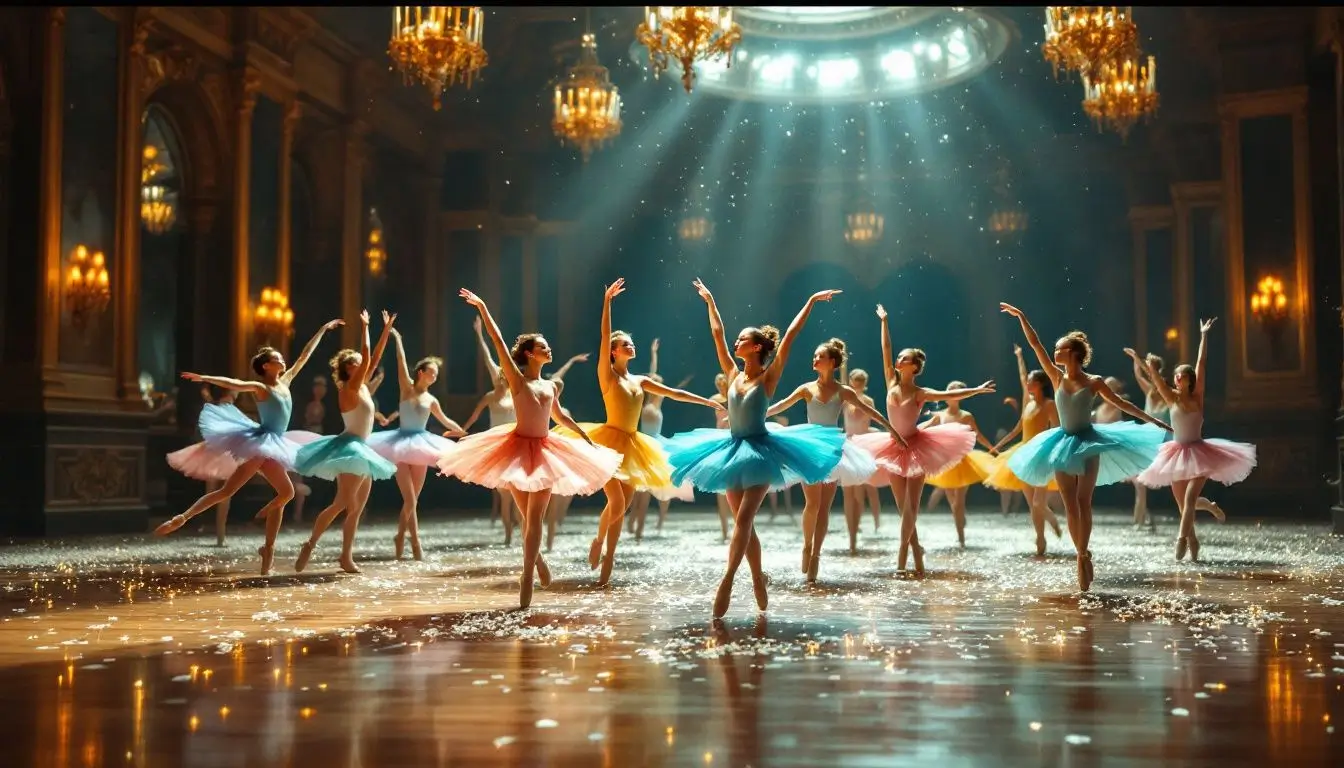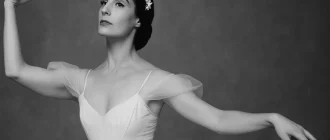Jerome Robbins was an American choreographer, director, and dancer. Renowned for his work in both ballet and Broadway, Robbins is a key figure in 20th-century American dance. But who is Jerome Robbins? He is best known for his groundbreaking choreography in productions like West Side Story and Fiddler on the Roof.’
As the New York City Ballet’s ballet master-in-chief, Robbins collaborated with Peter Martins and created numerous ballets, significantly influencing modern ballet and theatrical performances. This article explores his life, career, and lasting legacy in the performing arts.
Graceful Insights
- Jerome Robbins, originally named Jerome Wilson Rabinowitz, transitioned from a chemistry student to a leading figure in dance and theater. His early training and passion for the arts established a notable career.
- His breakthrough work, Fancy-Free, premiered in 1944 and laid the foundation for successful Broadway productions, including On the Town, West Side Story, and Fiddler on the Roof, showcasing his innovative choreography and storytelling.
- Robbins’ contributions to ballet and Broadway were complemented by his service in various arts organizations, including establishing the Jerome Robbins Foundation, which reflects his commitment to fostering and preserving the arts.
Art de Podcast
| Full Name | Jerome Wilson Rabinowitz (changed to Robbins) |
|---|---|
| Date of Birth | October 11, 1918 |
| Place of Birth | Manhattan, New York, U.S. |
| Profession | Choreographer, Director, Dancer |
| Notable Works | West Side Story, Fiddler on the Roof, On the Town, The King and I |
| Major Awards | 5 Tony Awards, 2 Academy Awards, Kennedy Center Honor, and others |
| Date of Death | July 29, 1998 |
| Legacy | Renowned for blending classical ballet, contemporary dance, and Broadway theatricality, profoundly influencing American dance and musical theater. |
Early Life and Education
Jerome Robbins, originally named Jerome Wilson Rabinowitz, was born at the Jewish Maternity Hospital on Manhattan’s Lower East Side. His family later moved to Weehawken, New Jersey, where his father and uncle started a corset company.
Robbins’s middle name, Wilson, was given in honor of President Woodrow Wilson, reflecting a family tradition of admiration for influential figures. Growing up in this vibrant environment, young Jerome developed a keen interest in the arts early on.
Robbins graduated from Woodrow Wilson High School in 1935. He enrolled at New York University to study chemistry, but his passion for the arts soon overshadowed his academic pursuits. His brief stint in chemistry was overshadowed by his growing fascination with dance, a shift that would set the stage for his illustrious career.
This pivotal moment led Robbins to leave New York University and immerse himself in the dance world. Choosing passion over a conventional path marked his journey’s first of many bold moves. During these formative years, he transitioned from a curious student to a dedicated artist, laying the foundations for his future success.
Transition to Dance

Jerome Robbins’s journey into dance began during high school when he studied modern dance under the tutelage of Alys Bentley. This early exposure to dance ignited a spark that would grow into a lifelong passion.
Robbins’ transition from chemistry to dance was not just a change of interest but a transformation driven by a deep-seated love for the art form. His decision to adopt the stage name ‘Robbins,’ suggested by his dance instructor, Senya Gluck Sandor, marked the beginning of his professional journey.
In pursuit of his dream, Robbins joined the American Ballet Theatre (ABT), where he trained under some of the most influential ballet instructors of the time. The rigorous training and exposure to the high standards of the ABT honed his skills as a ballet master and broadened his understanding of modern and classical dance.
His time at the School of American Ballet further refined his technique, preparing him for a career pushing the boundaries of performance art.
His association with prominent institutions like the American Ballet Theatre and the School of American Ballet significantly shaped his career as an associate artistic director, providing the technical prowess and creative insight needed to blend classical elegance with modern innovation, influenced by George Balanchine.
These early years in dance paved the way for a career marked by groundbreaking work and unparalleled success.
Breakthrough with ‘Fancy Free’
1944 marked a turning point in Jerome Robbins’ career with his ballet piece ‘Fancy-Free. Debut’ This work, a collaboration with composer Leonard Bernstein, showcased Robbins’ unique choreographic style and innovative approach to dance. ‘Fancy Free’ premiered on April 22, 1944, and was an instant success, capturing the imagination of audiences and critics alike.
‘Fancy-Free’ was not just a breakthrough; it paved the way for future triumphs in Broadway musicals. Its success led to its adaptation into ‘On the Town,’ further cementing Robbins’ creative reputation. This Broadway debut and musical’s initial success was a harbinger of the many accolades and recognitions that would follow in his illustrious career.
Broadway Triumphs

Jerome Robbins’s Broadway career was marked by triumphs that showcased his versatility and creative genius. His first major success came with the adaptation of Fancy-Free into the musical On the Town. Like many of Robbins’ works, this project was a collaboration with Leonard Bernstein, highlighting His ability to blend narrative and choreography seamlessly.
On the Town premiered on Broadway in 1944 and was a critical and commercial success, heralding the arrival of a new star in the Broadway firmament.
His versatility was evident in The Pajama Game, where he showcased talent in direction and choreography. His energetic and creative productions made him a sought-after figure on Broadway. Over the years, Robbins has had numerous accolades, including four Tony Awards, which have recognized his contributions to iconic productions such as Fiddler on the Roof.
One of Robbins’ most enduring legacies is his work on West Side Story, a modern retelling of Romeo and Juliet set in the streets of New York. This musical, which he co-created with Leonard Bernstein and Stephen Sondheim, redefined the genre and became a landmark in American theater. The choreography was groundbreaking, blending classical ballet with contemporary dance styles to tell a powerful story of love and conflict.
Robbins’ Broadway productions were transformative, setting new standards with compelling stories told through dance, ballet, theater, and music. Productions like ‘Billion Dollar Baby,’ ‘Miss Liberty,’ and ‘Jerome Robbins’ Broadway’ further solidified his status as a Broadway legend. His work continues to be celebrated and performed, ensuring his legacy endures in theater and dance.
Iconic Works: ‘West Side Story’ and ‘Fiddler on the Roof’

Two of Jerome Robbins’ most iconic works, West Side Story and Fiddler on the Roof, testify to his genius and enduring influence. West Side Story, a modern update of the classic play Romeo and Juliet, was a groundbreaking work that combined powerful storytelling with innovative choreography.
Robbins created and co-directed the film adaptation of West Side Story with Robert Wise, winning ten Academy Awards, including Best Picture. For his exceptional choreography in the first film version, Robbins received an Honorary Oscar, further cementing his legacy in theater and film.
‘Fiddler on the Roof’ is another cornerstone of Robbins’ career, deeply connected to his Jewish heritage. The musical, which explores themes of tradition, family, and cultural change, resonated with audiences worldwide. Robbins’ direction and choreography for ‘Fiddler on the Roof’ were critically acclaimed, earning him two Tony Awards. This work highlighted his ability to tell poignant stories through dance and showcased his deep understanding of cultural narratives.
These iconic works exemplify his talent for blending artistic elements into compelling, timeless pieces. West Side Story and Fiddler on the Roof continue to be celebrated globally, a testament to his extraordinary vision and lasting impact.
Contributions to Ballet

Jerome Robbins’ contributions to ballet were as significant as his work on Broadway. His association with the New York City Ballet saw him creating a repertoire of challenging and innovative pieces that reshaped the landscape of ballet. Among his significant works for the New York City Ballet are ‘The Cage’ and ‘Afternoon of a Faun,’ which remain staples in the ballet company’s repertoire.
His influence extended beyond the New York City Ballet. Robbins created ballets for various companies, including Ballets U.S.A. and the American Ballet Theatre. He made his works unique and accessible by integrating contemporary American themes. His collaboration with Leonard Bernstein and Stephen Sondheim on West Side Story is a prime example of how he bridged the gap between ballet and Broadway.
The enduring popularity of Robbins’s ballets, performed globally, highlights his lasting impact. His innovative choreography and storytelling have inspired countless dancers and choreographers, ensuring his legacy endures in ballet.
Artistic Style and Influences
Jerome Robbins’ artistic style was a unique amalgamation of ballet, modern, and jazz techniques, which he masterfully incorporated into his choreography. His tenure as associate artistic director of the New York City Ballet shaped his creative vision. Under the mentorship of George Balanchine, Robbins honed his ability to blend classical ballet with contemporary movements, creating a distinctive and innovative aesthetic.
Robbins’ choreography was renowned for its eclecticism and emotional depth. He had an uncanny ability to craft technically demanding and deeply resonant pieces. His work often featured complex rhythms and a keen sense of musicality, reflecting his collaborations with legendary composers like Leonard Bernstein and Stephen Sondheim.
A pivotal moment in Robbins’s career was the creation of the ballet Fancy-Free in 1944. Set to a vibrant musical score by Leonard Bernstein, this piece showcased Robbins’s talent for integrating ballet and jazz techniques. The success of Fancy-Free marked a turning point in his career and established him as a formidable force in the dance world.
Throughout his illustrious career, Robbins pushed the boundaries of dance and choreography. His Broadway productions, including iconic shows like West Side Story and Peter Pan, further solidified his reputation as a master choreographer and director. These works exemplified his ability to blend narrative and movement seamlessly, creating visually stunning and emotionally compelling performances.
Robbins’ legacy endures in the world of dance and theater. His choreography remains a staple of the New York City Ballet’s repertoire, and his influence is evident in the work of the ballet company and countless choreographers and directors. The Jerome Robbins Foundation, established in 1958, continues to support and promote the arts, ensuring that Robbins’ artistic vision and contributions will be celebrated for generations.
Later Career and Legacy

Jerome Robbins’s later career was marked by continued innovation and influence. He choreographed for the New York City Ballet until 1990, consistently pushing the boundaries of ballet and modern dance. His later works often reflected a more abstract and classical approach, showcasing his evolution as a choreographer. His ability to adapt and grow throughout his career kept his work relevant and influential.
In addition to his choreographic achievements, Robbins established the Jerome Robbins Foundation to support the arts and preserve his legacy. This foundation has been instrumental in promoting dance and theater, providing grants and support for artists and organizations.
Robbins served on the National Council on the Arts and was also a New York State Council on the Arts/Dance Pane member, demonstrating his commitment to fostering the arts.
He received two academy awards and numerous recognitions, including the Kennedy Center Honors, the National Medal of the Arts, and the Handel Medallion, testifying to his profound impact on American culture. Jerome Robbins’ legacy continues to inspire and influence dance and theater, ensuring his contributions are remembered for generations.
Service to the Arts
Beyond choreography, Jerome Robbins began dancing and ballet theatre. He dedicated himself to serving the arts in various capacities, including the National Council on the Arts and the New York State Council on the Arts/Dance Panel, where he helped shape arts policies and supported the dance community. His commitment to the arts extended to his efforts to preserve his work and contributions by establishing the Jerome Robbins Film Archive.
Robbins’s influence on commercial theater was not limited to dance and theater; he also significantly contributed to televised performances. He directed the Ford 50th Anniversary Show, showcasing his versatility and impact on the medium.
Robbins’s lifelong dedication to the arts and efforts to elevate and preserve them have left an enduring legacy that continues to benefit the artistic community.
Resume
Extraordinary achievements and a lasting legacy in dance and theater marked Jerome Robbins’ life and career. From his early years and transition to dance to his groundbreaking work on Broadway and contributions to ballet, Robbins consistently pushed the boundaries of artistic expression.
His dedication to the arts, through his creative works and service to the artistic community, ensured his influence would be felt for generations to come. Jerome Robbins’ story is one of passion, innovation, and an unwavering commitment to excellence, inspiring artists and audiences alike.
Frequently Asked Questions
Where was Jerome Robbins born?
Jerome Robbins was born in the Jewish Maternity Hospital on Manhattan’s Lower East Side.
What was Jerome Robbins’ first major success on Broadway?
Jerome Robbins’ first major success on Broadway was the musical ‘On the Town,’ adapted from his ballet ‘Fancy Free.’ This work marked a significant milestone in his career.
How did Jerome Robbins contribute to ballet?
Jerome Robbins significantly advanced ballet through his innovative and challenging works for the New York City Ballet, fundamentally reshaping the art form. His contributions have left a lasting impact on the ballet landscape.
What are some of Jerome Robbins’ most iconic works?
Jerome Robbins’ most iconic works include ‘West Side Story’ and ‘Fiddler on the Roof,’ which were celebrated for their critical acclaim and numerous awards. These productions have left a lasting impact on the world of musical theatre.
What is the Jerome Robbins Foundation?
The Jerome Robbins Foundation supported the arts and preserved the legacy of Obbins. It focuses on providing grants and assistance to artists and organizations.







